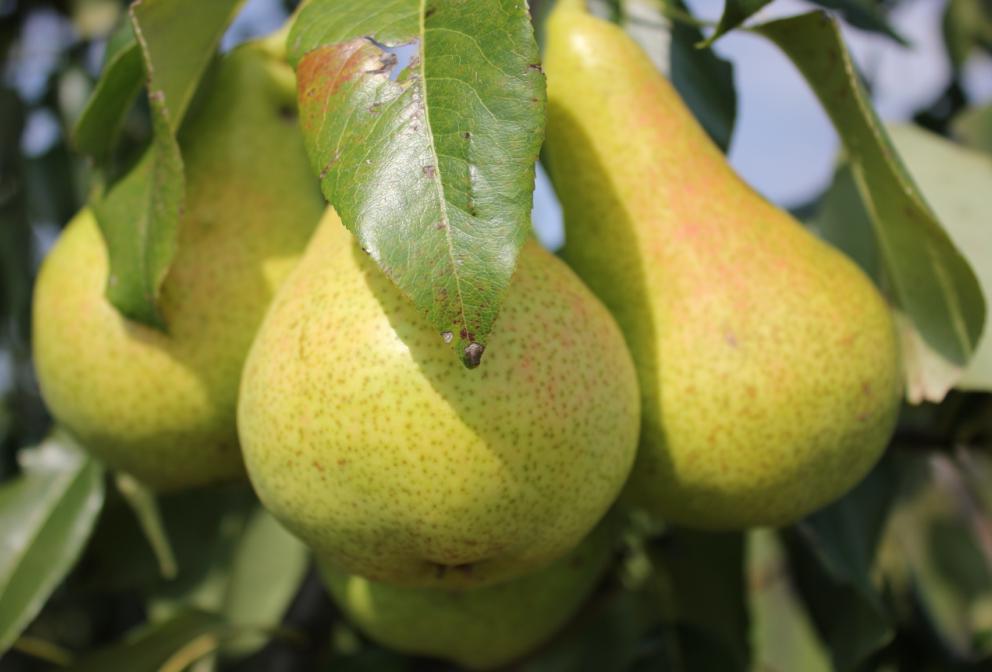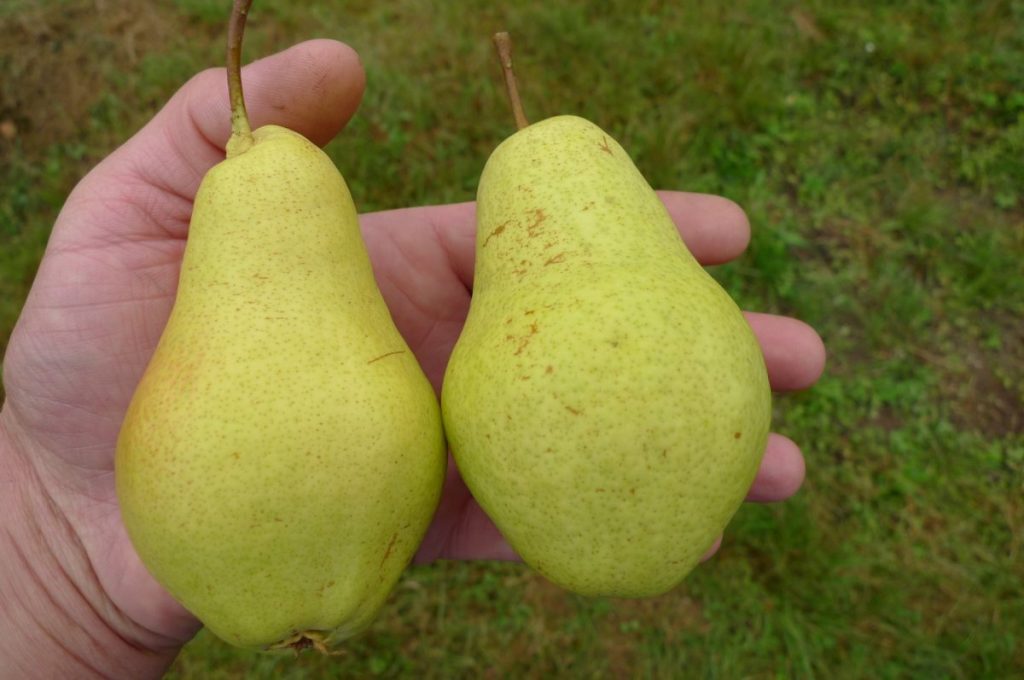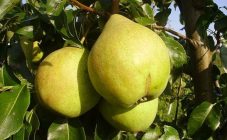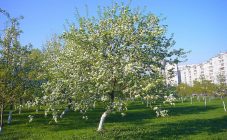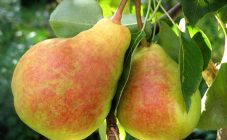Content:
Pear Vidnaya belongs to a group of relatively young varieties, but this did not prevent it from becoming extremely famous and in demand among gardeners of central Russia in half a century. This culture is endowed with a lot of advantages, for example, it is undemanding to the soil and has high winter hardiness. Another plus of the fruit tree is regular and abundant fruiting. The pear is self-pollinated, therefore it does not need other varieties in the neighborhood.
Pear variety Prominent: full characteristics
Pear Vidnaya belongs to late summer varieties, was bred by crossing the hybrid form 53-67 with a mixture of pollen of southern varieties in Moscow (1958). Due to the unusual appearance of the fruit, the plant also has an alternative name - Bumpy. Already in 1972, the variety became one of the leaders. Designed for cultivation in the Central region. The most common in the Moscow region and the surrounding areas.
The pear is conspicuous, is in great demand when grown on an industrial scale, and has value for breeding work.
The trees are vigorous, young trees have a spreading crown, but as it develops, it acquires a pyramidal shape, it is characterized by an average foliage. The main branches are powerful, ringlets are characterized by large sizes.
The shoots are light brown in color, rather long, have an average thickness. The leaves are medium in size, the surface of the leaf blade is smooth, the edges are slightly raised. The petioles are medium in thickness and length.
The sizes of the fruits are medium or large, the average weight varies from 150 to 180 grams, the shape is elongated pear-shaped, the surface of the peel is uneven and ribbed, moderately dense. The color is yellow-green, but in the process of aging, a reddish blush is formed. Seed chambers are miniature, closed.
The structure of varietal fruits is dense and oily, the color is white with a yellowish tint. Excellent sweet and sour taste.
Harvest time is at the end of August. The fruits ripen gradually, which makes it possible to process the crop; fruits are harvested, as a rule, in 2-3 stages. First of all, the largest and ripe ones are collected, located on the southeast and south sides. Thanks to this approach, it will be possible to extend the season for the consumption of fresh pears. Ripe pears do not crumble.
The early maturity of the variety is average, as a rule, the first fruits of the trees begin to bear 4-5 years after planting. Fruiting in trees is regular and abundant, from each tree it is possible to collect from 40 to 60 kg of fruits. Decent cold resistance, not inferior to old varieties for the middle lane. There is a high resistance to fungal diseases.
The variety is self-fertile, flowering occurs at the end of May.
Pear agrotechnics Vidnaya
The optimal time for planting in the southern regions is in September or October, and in the northern regions in April. The plant is undemanding to the composition of the soil, it can grow even on clay soil. However, it will bear fruit more abundantly, of course, on black soil.
The tree needs moderate lighting and moisture, groundwater should be located no higher than 2 meters from the earth's surface.
When purchasing planting material, it is necessary to carefully inspect the root system and trunk of the seedling, they should not have mechanical damage, growths and stains, the surface should be smooth. The planting hole should be prepared in advance so that it is ventilated and compacted, otherwise, after planting, the root collar may sink into the ground, begin to rot and the seedling will die.
Landing Algorithm:
- Prepare a pit 1 m deep and up to 0.8 m wide.
- It is recommended to add potassium nitrate, superphosphate and compost to the topsoil. The resulting mixture is poured and evenly distributed over the bottom of the pit.
- A few days before the expected date of planting, the seedling is placed in a solution of warm water with root-stimulating drugs, for example, Kornevin or Epin.
- A few hours before planting, they put it in a chatterbox (a mixture of clay and manure), then take it out and dry it.
- A peg is inserted in either side of the center of the pit; it will be a support for an immature seedling.
- The seedling is placed on the bottom and the root system is carefully spread. As the pit falls asleep, the soil must be tamped so that voids do not form between the roots. The root collar should be located 5-7 cm above ground level. The earth is tamped again and the pear is tied to a support.
- The final stage is abundant watering (at least 35 liters) and mulching (compost, peat, straw and grass).
Care
Compliance with agrotechnical rules will provide the fruit tree with "heroic" health, and the agronomist - with a plentiful and high-quality harvest. During the first year of life, the plant needs weekly watering, at least 20 liters of water are used at a time. As the rhizome develops, the tree itself will provide itself with moisture from the depths of the soil.
An adult pear is watered three times during the growing season: during the formation of buds, during the ovary of the fruits and 2-3 weeks before they ripen. The optimal amount of water is 40-60 liters.
In the second year after planting, it's time to start applying mineral or organic fertilizers to the soil. It is important that the soil is moistened during feeding.
Fertilization features:
- During the first loosening and active formation of shoots, nitrogen-containing preparations are used.
- With an interval of 2-3 years, organic fertilizers such as a solution of bird droppings or mullein, as well as humus or compost are applied.
- With the onset of autumn, it is advisable to apply potash and phosphorus-containing fertilizers to the soil.
Without regular sanitary pruning, the crown thickens, which is why the fruits become smaller. In addition, a pear is a tall tree that, without proper crown formation, can stretch up to 7 meters.
An annual seedling is cut by 0.5 m, after which several powerful shoots are formed on it, which will become the frame for the crown. In subsequent years, it is necessary to start forming a sparse-tiered crown.
It is better to start sanitary pruning in the fall, when the air warms up to +5 degrees. It is necessary to cut not only lateral shoots, but also damaged, frozen, non-fertile and affected by diseases / pests. During pruning, sharp and clean objects should be used, preferably cut at once in order to less damage the wood. It is important to thoroughly treat all cut points with a solution of a garden varnish.
Advantages and disadvantages of the variety
Main advantages:
- The regularity of fruiting. The amount of the harvested crop from year to year differs insignificantly and depends on the weather conditions in summer.
- Excellent taste, tasters rated the taste of the fruit at 4.2 points out of 5.
- The variety can be grown commercially as the fruit is attractive.
- Self-fertility. A fruit tree does not need a pollinator; it can bear the maximum amount of fruit on its own. This is true for owners of a small area of land.
- High resistance to dangerous fungal diseases - scab and powdery mildew (false, common).
- After planting, the tree begins to bear fruit after 4-5 years.
- Unpretentiousness to the composition of the soil, the trees of the Vidnaya variety adapt and bear fruit even on poor clay soils.
- Excellent indicators of cold resistance, which is important when growing a fruit tree in adverse climatic conditions.
- Late flowering. The buds begin to bloom at the end of May, when the probability of frost is close to zero.
Despite the large number of advantages, there are also disadvantages:
- The tree is tall, which makes it difficult to care for and harvest.
- Poor keeping quality of fruits, pear storage duration is no more than 5-7 days.
The variety of pears has many positive features, thanks to which it is famous among agronomists living in the middle lane. It may seem to many novice summer residents that it is difficult to grow a healthy and abundantly fruitful tree, but this is a delusion. Vidnaya pear variety is unpretentious in care, even a beginner can grow it.
